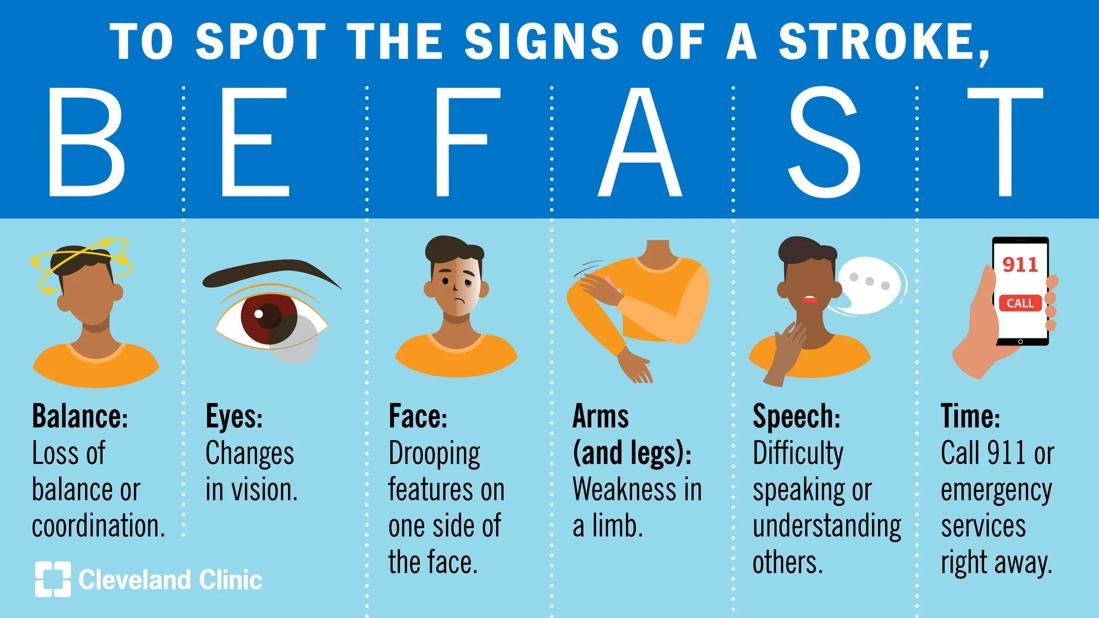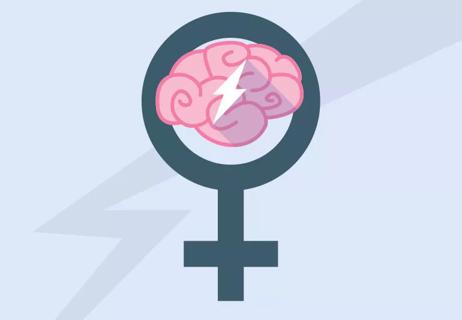Seek immediate medical attention for sudden loss of balance, vision changes, slurring, facial droopiness and limb weakness

Here’s a scary fact for you: Only an estimated 36% of people in the U.S. know even one of the signs of a stroke.
Advertisement
Cleveland Clinic is a non-profit academic medical center. Advertising on our site helps support our mission. We do not endorse non-Cleveland Clinic products or services. Policy
“The most common signs people know about are facial droopiness and limb weakness,” says neurologist Blake Buletko, MD, “but there are other important signs to know about, too, so you can take quick action if you think you or someone else is having a stroke.”
Dr. Buletko explains the acronym BE FAST, which can help you remember the six major signs of a stroke.
BE FAST is an acronym, meaning each letter of these two words stands for a different sign of stroke: Balance, Eyes, Face, Arms, Speech and Time.
“Remembering BE FAST can help you recognize when you or someone else is having a stroke in order to seek immediate care,” Dr. Buletko says. But what does the term BE FAST mean in practice? Let’s take a closer look:
Advertisement
“Remember that in the case of a stroke, you’re looking for sudden signs and symptoms,” Dr. Buletko stresses.
If these signs and symptoms occur over a longer period of time (several hours to days to weeks), they may be signs of other medical conditions (for example, Bell’s palsy can cause droopy features, and migraines can cause double vision). But when they appear suddenly and together, think stroke — and act accordingly.
Running through the BE FAST stroke acronym can help you determine whether you or someone else is having a stroke. Then, for the best chance of survival and recovery, it’s critical to receive care as quickly as possible.
“‘Time is brain’ — that’s what we say over and over and over again,” Dr. Buletko says. “You lose millions of neurons for every single minute your brain isn’t getting enough blood.”
During a stroke, you lose as many as 2 million brain cells per minute. This is one of the many reasons not to downplay the seriousness when it comes to the warning signs of a stroke.
“I encourage people not to dismiss these symptoms,” he states, “and I also encourage you not to think that you can get to an emergency department on your own faster than calling 911.”
Why call for help instead of trying to rush to the hospital yourself? It all comes down to the time it takes for you to get care. Paramedics are trained and equipped to assess your condition and provide on-the-go care that can save your life as they transport you to a hospital that can treat you. In some cases, they may even be able to give you anti-clotting medications and do a CT scan on the way there.
“It’s extremely important to try to deliver stroke care as quickly as possible,” Dr. Buletko reiterates, “so the best thing to do is always to call 911.”
Advertisement
Learn more about our editorial process.
Advertisement

Strokes in the left side of the brain are more common and the effects are typically more noticeable

Your age, the type of stroke you had, the cause and the location can all impact your recovery

It can be overwhelming, but habit changes help lower your risk of another stroke

Hormonal changes and pregnancy are some factors unique to women

What you eat may protect you from a ‘brain attack’

Know the warning signs + decrease your risk

The short answer from a vascular neurologist

Watch for depression, behavior changes

Babies can get congested easily, but you can calm their cough by keeping them hydrated, using nasal drops and running a humidifier

Weight loss may cause loose, sagging skin and muscle loss to your rear

Several conditions, like vitiligo and fungal infection, can cause a loss of pigmentation, leading to white spots or patches on your skin